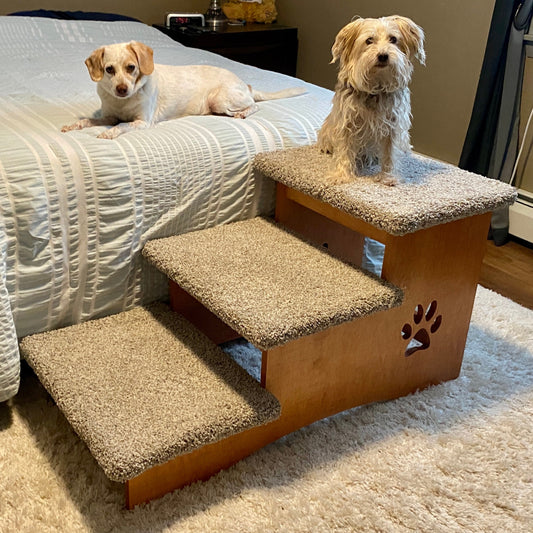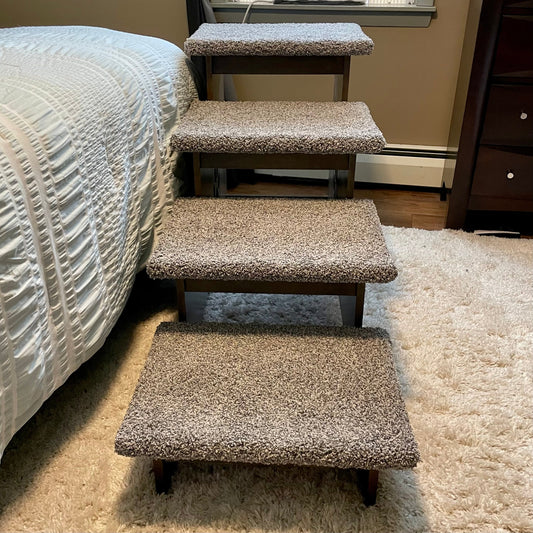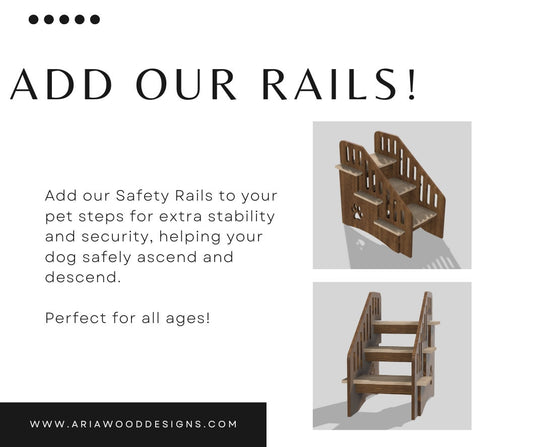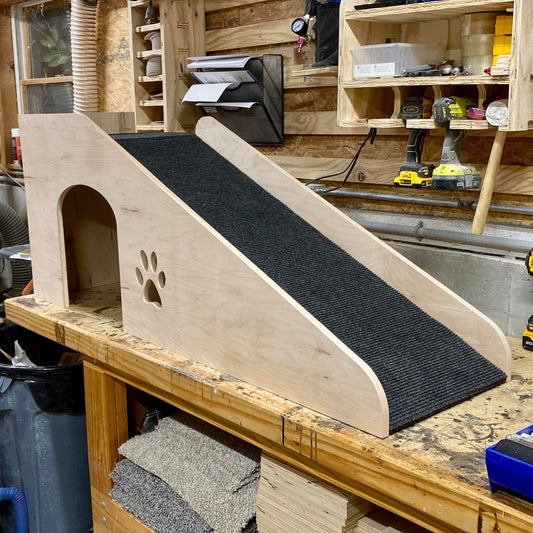Your small dog stands at the edge of your tall bed, looking up with hopeful eyes. They want to join you for bedtime snuggling, but the jump seems impossible. Sound familiar? You're not alone. Many pet owners face this daily challenge with their furry companions.
Dog ramps for beds offer an elegant solution to this common problem. These specially designed accessories provide safe, gradual access to elevated surfaces, protecting your pet's joints while maintaining their independence. Whether you have a senior dog with arthritis, a small breed like a Dachshund or Corgi, or simply want to prevent future joint issues, the right bed ramp can transform your pet's quality of life.
This comprehensive guide covers everything you need to know about choosing the perfect dog ramp for your bed. From understanding different types and storage features to selecting the right size and ensuring proper safety features, you'll discover how to make bedtime comfortable and stress-free for both you and your beloved pups.

Understanding Different Types of Dog Bed Access Solutions
When shopping for bed access solutions, you'll encounter two main categories: dog ramps and dog stairs. Each option offers distinct advantages depending on your pet's specific needs.
Dog Bed Ramp vs Dog Steps
Dog ramps feature a smooth, inclined surface that allows pets to walk up gradually without lifting their legs high. This design particularly benefits dogs with hip issues, arthritis, or mobility challenges. The gentle slope reduces stress on joints and provides excellent traction for confident climbing.
Dog stairs consist of individual steps that create a stair-like structure. These work well for pets comfortable with stepping motions and often require less floor space than ramps. Many dog stairs feature wide, deep steps that accommodate different paw sizes and provide a stable footing.
Material Considerations
Most high-quality dog ramps and stairs use solid wood construction for unmatched strength and durability. Wood offers several advantages:
- Stability: Heavy enough to resist sliding during use
- Longevity: Withstands daily use from pets of all sizes
- Customization: Can be stained or finished to match bedroom furniture
- Safety: Provides reliable support without wobbling
Some manufacturers also offer foam or plastic alternatives, though these typically lack the durability and stability of wooden constructions.

Choosing the Right Size for Your Bed and Pet
Proper sizing ensures your dog ramp provides safe, comfortable access while fitting seamlessly into your bedroom space.
Measuring Your Bed Height
Start by measuring the exact height from your floor to the top of your mattress. Common bed heights range from 14 inches for low platform beds to 30 inches for tall beds with box springs and thick mattresses. This measurement determines the ramp height you'll need.
Considering Your Dog's Size and Breed
- Small dogs (under 25 pounds) typically need gentler slopes and may struggle with steep inclines. Breeds like Dachshunds, Corgis, and Basset Hounds have short legs that make jumping particularly difficult and potentially harmful.
- Large dogs require wider ramps with deeper steps to accommodate their bigger paws and longer stride. Golden Retrievers, German Shepherds, and similar breeds benefit from extra-wide designs that prevent slipping off the sides.
- Senior dogs of any size need the most gradual inclines possible, as their joints may be stiff and their confidence reduced.
Space Requirements
Consider your bedroom layout when selecting ramp dimensions. Longer ramps provide gentler slopes but require more floor space. Measure the available area next to your bed to ensure the ramp won't obstruct walkways or create safety hazards for humans.

Essential Safety Features to Look For
Safety should be your top priority when selecting a dog ramp for your bed. Several key features distinguish high-quality options from inferior alternatives.
Non-Slip Surfaces
Look for ramps with carpeted or textured surfaces that provide excellent traction. Quality carpet prevents slipping even when your pet's paws are wet or if they're wearing protective booties. Some ramps feature specialized pet-friendly carpeting designed specifically for grip and durability.
Side Rails and Barriers
Side rails prevent pets from accidentally stepping off the ramp while climbing. These safety features prove especially valuable for:
- Senior dogs with vision issues
- Pets using the ramp during nighttime darkness
- Dogs are still learning to use their new ramp confidently
Great Quality and Sturdy Construction
Quality ramps support pets weighing up to 150 pounds or more. Look for solid wood construction with reinforced joints and heavy-duty hardware. Pocket-hole joinery, a professional woodworking technique, creates exceptionally strong connections that won't loosen over time.
Stable Base Design
The ramp's base should remain firmly planted during use. Wide bases and non-slip feet prevent sliding on smooth floors like hardwood or tile. Some designs include rubber pads that grip various flooring types effectively.

Benefits for Different Dog Breeds and Ages
Dog ramps provide specific advantages for various types of pets, addressing unique needs based on breed characteristics and life stages.
Small Dogs and Breed Benefits
- Dachshunds, with their long backs and short legs, face heightened risks of spinal injuries from jumping. A quality ramp eliminates this danger while preserving their independence.
- Corgis share similar proportions and benefit greatly from gentle access ramps. Their herding instincts often make them eager to be wherever their family members are, making bed access particularly important.
- Other small breeds, including Chihuahuas, Yorkshire Terriers, and Cavalier King Charles Spaniels, gain confidence and safety from proper ramp access.
Senior Dog Advantages
Older dogs often develop arthritis in their hips, knees, and spine. Jumping down from beds can cause pain and potentially worsen existing conditions. Ramps allow these beloved pets to maintain their cherished sleeping arrangements without discomfort.
The gradual incline reduces joint stress significantly compared to jumping. Many senior dogs who've stopped accessing beds due to pain rediscover their favorite sleeping spots once ramps are installed.
Large Breed Considerations
While large dogs might seem capable of jumping easily, they actually face increased risks from repeated impacts. Great Danes, German Shepherds, and Golden Retrievers can develop joint problems from regular jumping, especially onto hard floors.
Extra-deep steps accommodate their larger paws and longer strides, ensuring comfortable, confident use. Wide platforms provide stability for breeds that might otherwise feel unsteady on narrow access points.

Installation and Training Tips
Successfully introducing a dog ramp requires patience and proper setup techniques.
Proper Placement
Position the ramp at a stable angle against your bed. Most ramps work best at angles between 20 and 30 degrees, providing manageable slopes without being too steep. Ensure the top of the ramp sits securely against the mattress edge.
Test the setup by gently pressing on different ramp areas to verify stability. Any wobbling or sliding indicates the need for repositioning or additional stabilization.
Introducing Your Pet to the Ramp
Start training during daylight hours when your pet can clearly see the new equipment. Place treats on each step or along the ramp surface to encourage exploration.
Begin with your pet at the bottom and encourage them to step onto the first level. Reward progress with treats and praise. Some dogs adapt immediately, while others need several days of gradual introduction.
Never force your pet onto the ramp, as this can create negative associations. Instead, make the experience positive through patience and rewards.
Nighttime Considerations
Once your pet masters daytime use, nighttime access typically follows naturally. Consider adding a small nightlight near the ramp area to help pets navigate safely in the darkness.
Some pet owners find that gently guiding their dog to the ramp bottom during nighttime bathroom breaks helps reinforce the routine.

Maintenance and Care
Proper maintenance ensures your dog ramp remains safe and functional for years to come.
Regular Safety Inspections
Check hardware monthly to ensure screws remain tight and joints stay secure. Look for signs of wear on carpet surfaces and replace when traction diminishes.
Inspect the base regularly for damage, especially if your pet weighs more than 50 pounds. Heavy use can gradually loosen connections or wear down stabilizing features.
Cleaning Guidelines
Most carpeted ramps can be vacuumed regularly to remove pet hair and debris. Spot clean accidents immediately with pet-safe cleaners to prevent odors and staining.
For deeper cleaning, many pet-friendly carpets can be steam cleaned, though check manufacturer recommendations first. Avoid harsh chemicals that might create slippery surfaces or harmful residues.
Protecting Your Investment
Quality wooden ramps can last decades with proper care. Keep them away from excessive moisture, which can cause warping or finish damage. If your bedroom tends to be humid, ensure adequate ventilation around the ramp area.

Frequently Asked Questions
Will my dog actually use a ramp?
Most dogs adapt to ramps quickly, especially when introduced gradually with positive reinforcement. Small dogs and seniors often show immediate appreciation for the easier access. Some dogs may need a few days to build confidence, but persistence usually pays off.
How much weight can dog ramps support?
Quality wooden ramps typically support 100-200 pounds, making them suitable for pets of all sizes. Always check manufacturer specifications and choose ramps rated well above your pet's weight for an extra safety margin.
Can ramps damage my flooring?
Well-designed ramps include protective feet or pads that prevent scratching hardwood, tile, or laminate floors. Look for models specifically designed with floor protection in mind.
Do I need different ramps for different bed heights?
Yes, ramp height should match your bed height for optimal safety and usability. Some manufacturers offer multiple height options to accommodate various bed configurations.
How do I clean pet accidents from carpet ramps?
Clean accidents immediately with pet-safe enzymatic cleaners. Blot rather than rub to avoid spreading stains. Most pet-friendly carpets resist odors and clean easily with proper products.

Why Choose Aria Wood Designs for Dog Stairs and Ramps?
When it comes to quality and functionality, Aria Wood Designs stands out as a top choice for the best dog ramps and stairs. Carefully crafted with a focus on durability and elegance, their products are designed to seamlessly blend into your home while providing safe and reliable access for your furry friends. Aria Wood Designs prioritizes premium materials, ensuring long-lasting solutions that can accommodate pets of all sizes, from small breeds to larger, senior dogs.
Additionally, these ramps and stairs are thoughtfully engineered with your dog's comfort and safety in mind, featuring non-slip surfaces and sturdy construction to prevent accidents.
Not only do they make life easier for your pet, but they also enhance your peace of mind. Aria Wood Designs takes pride in offering customizable options, allowing you to select the size, color, and style that best fit both your dog's needs and your home aesthetic. Investing in Aria Wood Designs means choosing a brand that combines functionality, safety, and style, making them the ultimate solution for pet access to elevated spaces like beds and couches.

Making the Right Choice for Your Pet's Needs
Selecting the perfect dog ramp for your bed transforms both your pet's comfort and your peace of mind. Quality ramps provide years of reliable service while protecting your furry friend's joints and maintaining their independence.
Consider your pet's specific needs: their size, age, mobility level, and personality. Factor in your bedroom space, couch space, and bed height to ensure proper fit and function to make the process super easy. Most importantly, prioritize safety features and construction quality over price alone.
A well-chosen dog ramp becomes an invisible part of your daily routine, quietly ensuring your pet can access their favorite sleeping spot safely and comfortably. The investment in your pet's long-term health and happiness makes every consideration worthwhile.
Your loyal companion deserves safe, easy access to the comfort they crave. With the right ramp, bedtime becomes a stress-free experience for everyone in the family—two-legged and four-legged alike.









